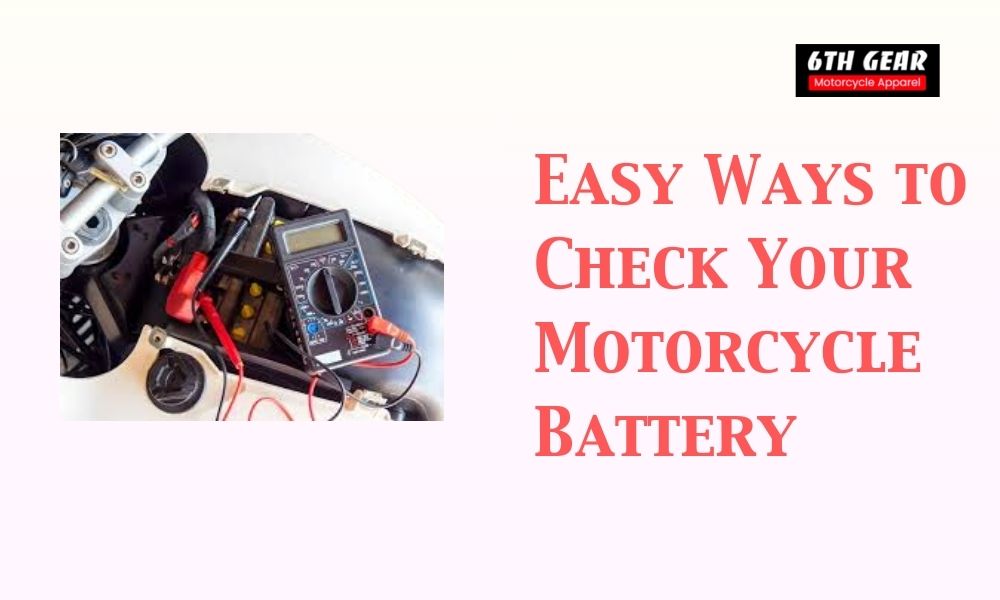Easy Ways to Check Your Motorcycle Battery

You’re ready for a ride, the engine should roar, but instead—you hear a click or maybe nothing at all. Your motorcycle’s battery is probably the problem. As the central component of a motorcycle’s electrical system, batteries can save you from becoming stranded if you know how to check their condition.
Many riders wait until it’s too late to take this easy step, but mastering it now will ultimately result in fewer surprises and more comfortable rides.
Why Voltage Matters More Than You Think
Most riders know their bikes run on 12 volts. Ask anyone, how many volts is a motorcycle battery, and you’ll usually hear “twelve.” But here’s where many get tripped up. That number is just the label, not the whole story.
When you put a meter on a healthy battery, it should read around 12.6 to 12.8 volts. That’s fully charged. Drop to 12.4 and you’re already on the weaker side. Anything near 12 or lower? That battery won’t give you much.
So, next time you wonder, what is the voltage of a motorcycle battery, remember it’s not about the number printed on the case—it’s about the reading you get right now.
A Multimeter Is Your Best Friend
Testing isn’t complicated. Grab a multimeter—cheap, pocket-sized, and one of the best tools you’ll ever own. Switch it to DC volts. Touch the red lead to the positive terminal, the black to negative. Done. You’ve just measured the battery voltage for motorcycle health in seconds.
If the number is above 12.6, your battery’s happy. If it hovers lower, you’re on borrowed time. This is the foundation of testing motorcycle battery condition, and once you’ve done it once, you’ll never ride blind again.
Don’t Stop at a Resting Test
Here’s a mistake many riders make: they test only when the engine’s off. That tells you if the battery is charged, but not if the charging system is doing its job. Start the bike. Test again.
Now the reading should jump to somewhere between 13.5 and 14.5 volts. That’s the alternator feeding the system and keeping the battery alive. This is how motorcycle batteries charge—through the alternator, regulated before it hits the battery.
Too low, and you’re not charging. Too high, and the regulator may be failing. Either way, a battery can’t survive long without proper charging.
Can a Car Help You Out?
At some point, every rider has asked: can you charge a motorcycle battery with a car? The honest answer—yes, but it’s risky. Both batteries are 12 volts, but a car battery is much stronger. Hooking up with the car engine running can fry your bike’s battery in seconds.
If you’re desperate, connect with the car engine off, and only long enough to fire up your bike. But if you care about battery life, invest in a motorcycle charger. It’s designed for smaller batteries and charges safely without the risk of overload.
When the Bike Speaks Louder Than Numbers
Sometimes, you don’t even need a meter. Your bike tells you when the battery’s on its last legs. The starter motor drags, headlights fade when you crank, or the dash flickers like an old bulb.
If you’re asking yourself daily whether the bike will start, you already know the answer. Even if your meter says the motorcycle battery voltage is fine, those signs mean it’s losing the ability to hold charge. Numbers alone can lie; behavior rarely does.
Keep the Juice Flowing
A lot of batteries don’t die—they’re killed. Let a bike sit through winter without care, and you’ll meet a dead battery in spring. That’s why many riders keep a trickle charger in the garage. It feeds just enough power to keep the battery alive without overdoing it.
Another silent killer? Corrosion. White crust on the terminals blocks power and stresses the system. A quick clean with a wire brush and a dab of grease keeps connections solid. Simple habits like these make your battery last longer.
Load Tests: The Truth Serum
Here’s where things get serious. Voltage tests tell you the charge. A load test tells you the strength. It puts the battery under stress—like simulating a cold start—and shows if it can actually perform.
Some shops will do it for free, or you can buy a tester. Even if your meter shows 12.6 volts, a weak battery will fail a load test. That’s why seasoned riders trust both methods.
So, When Do You Replace?
Batteries aren’t forever. On average, you’ll get three to five years from a motorcycle battery. After that, it’s a gamble. If you’re already asking how to check motorcycle battery every ride, the safer move is replacement. Think of it like swapping tires before a long trip—you don’t wait for them to blow.
Quick Numbers to Remember
Here’s a cheat sheet worth memorizing:
- 12.6–12.8 volts: Healthy
- 12.4–12.5 volts: Weakening
- 12.0–12.3 volts: Low, risky
- Below 12 volts: Likely dead
These numbers answer common questions like how many volts are in a motorcycle battery or what voltage battery is in a motorcycle in real-world terms.
Wrapping It Up
At the end of the day, checking your motorcycle battery isn’t just about reading numbers on a meter. It’s about avoiding those moments when your bike refuses to start. You can ride with confidence rather than nervousness when you know how a motorcycle battery charges, what its voltage is, and when maintenance is due.
Develop a habit of periodically checking the battery. Keep the terminals clean, use a multimeter, and keep an eye on the charging voltage. Unless there is an emergency, avoid dangerous fixes like jumping from a car. By taking these easy procedures, you can avoid hassles later on and maintain your bike ready for the road.
Do you want easier-to-follow riding instruction and gear recommendations? For guides that keep you moving forward without any surprises, check out Six Gear.
















